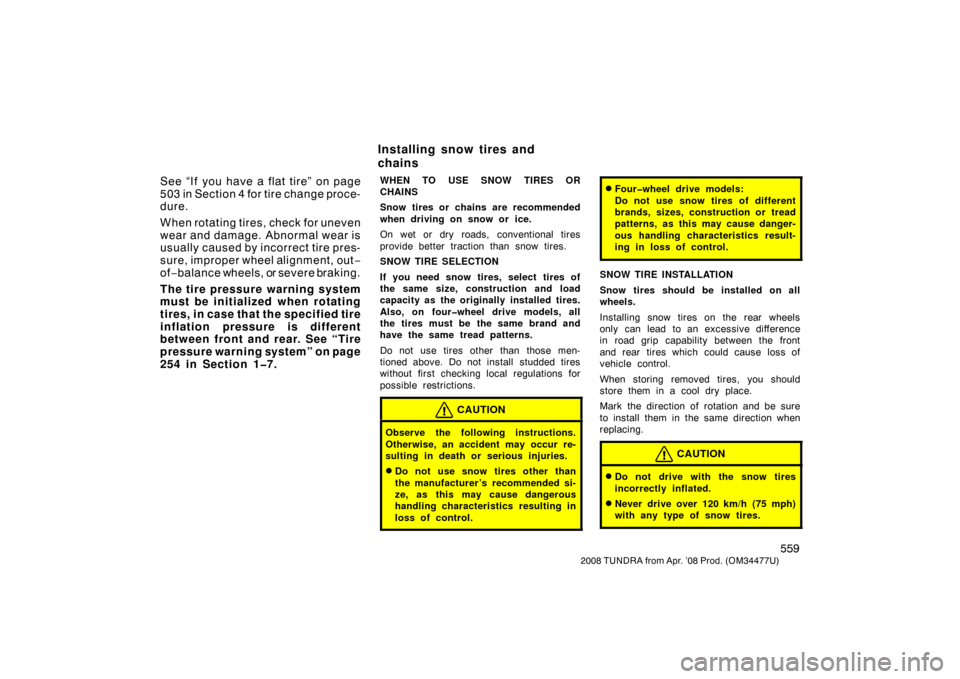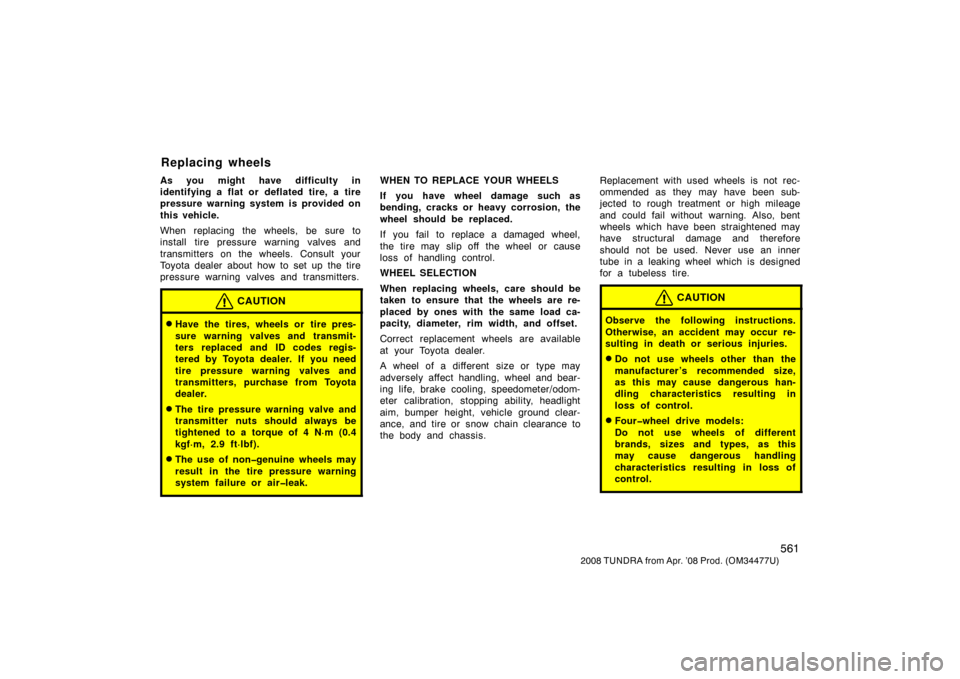Page 569 of 621

559
2008 TUNDRA from Apr. ’08 Prod. (OM 34477U)
See “If you have a flat tire” on page
503 in Section 4 for tire change proce-
dure.
When rotating tires, check for uneven
wear and damage. Abnormal wear is
usually caused by incorrect tire pres-
sure, improper wheel alignment, out −
of −balance wheels, or severe braking.
The tire pressure warning system
must be initialized when rotating
tires, in case that the specified tire
inflation pressure is different
between front and rear. See “Tire
pressure warning system” on page
254 in Section 1�7.WHEN TO USE SNOW TIRES OR
CHAINS
Snow tires or chains are recommended
when driving on snow or ice.
On wet or dry roads, conventional tires
provide better traction than snow tires.
SNOW TIRE SELECTION
If you need snow tires, select tires of
the same size, construction and load
capacity as the originally installed tires.
Also, on four�wheel drive models, all
the tires must be the same brand and
have the same tread patterns.
Do not use tires other than those men-
tioned above. Do not install studded tires
without first checking local regulations for
possible restrictions.
CAUTION
Observe the following instructions.
Otherwise, an accident may occur re-
sulting in death or serious injuries.
�Do not use snow tires other than
the manufacturer ’s recommended si-
ze, as this may cause dangerous
handling characteristics resulting in
loss of control.
�Four�wheel drive models:
Do not use snow tires of different
brands, sizes, construction or tread
patterns, as this may cause danger-
ous handling characteristics result-
ing in loss of control.
SNOW TIRE INSTALLATION
Snow tires should be installed on all
wheels.
Installing snow tires on the rear wheels
only can lead to an excessive difference
in road grip capability between the front
and rear tires which could cause loss of
vehicle control.
When storing removed tires, you should
store them in a cool dry place.
Mark the direction of rotation and be sure
to install them in the same direction when
replacing.
CAUTION
�Do not drive with the snow tires
incorrectly inflated.
�Never drive over 120 km/h (75 mph)
with any type of snow tires.
Installing snow tires and
chains
Page 571 of 621

561
2008 TUNDRA from Apr. ’08 Prod. (OM 34477U)
As you might have difficulty in
identifying a flat or deflated tire, a tire
pressure warning system is provided on
this vehicle.
When replacing the wheels, be sure to
install tire pressure warning valves and
transmitters on the wheels. Consult your
Toyota dealer about how to set up the tire
pressure warning valves and transmitters.
CAUTION
�Have the tires, wheels or tire pres-
sure warning valves and transmit-
ters replaced and ID codes regis-
tered by Toyota dealer. If you need
tire pressure warning valves and
transmitters, purchase from Toyota
dealer.
�The tire pressure warning valve and
transmitter nuts should always be
tightened to a torque of 4 N·m (0.4
kgf·m, 2.9 ft·lbf).
�The use of non�genuine wheels may
result in the tire pressure warning
system failure or air�leak.
WHEN TO REPLACE YOUR WHEELS
If you have wheel damage such as
bending, cracks or heavy corrosion, the
wheel should be replaced.
If you fail to replace a damaged wheel,
the tire may slip off the wheel or cause
loss of handling control.
WHEEL SELECTION
When replacing wheels, care should be
taken to ensure that the wheels are re-
placed by ones with the same load ca-
pacity, diameter, rim width, and offset.
Correct replacement wheels are available
at your Toyota dealer.
A wheel of a different size or type may
adversely affect handling, wheel and bear-
ing life, brake cooling, speedometer/odom-
eter calibration, stopping ability, headlight
aim, bumper height, vehicle ground clear-
ance, and tire or snow chain clearance to
the body and chassis. Replacement with used wheels is not rec-
ommended as they may have been sub-
jected to rough treatment or high mileage
and could fail without warning. Also, bent
wheels which have been straightened may
have structural damage and therefore
should not be used. Never use an inner
tube in a leaking wheel which is designed
for a tubeless tire.
CAUTION
Observe the following instructions.
Otherwise, an accident may occur re-
sulting in death or serious injuries.
�Do not use wheels other than the
manufacturer ’s recommended size,
as this may cause dangerous han-
dling characteristics resulting in
loss of control.
�Four�wheel drive models:
Do not use wheels of different
brands, sizes and types, as this
may cause dangerous handling
characteristics resulting in loss of
control.
Replacing wheels
Page 604 of 621
594
2008 TUNDRA from Apr. ’08 Prod. (OM 34477U)
Tire size, cold tire inflation pressure and wheel size:
Ti r e siz e
Cold tire inflation pressurekPa (kgf/cm2 or bar, psi)Temporary spareWheel size
FrontRear
P255/70R18 112T210 (2.1, 30)230 (2.3, 33)230 (2.3, 33)18 �8J
P275/65R18 114T210 (2.1, 30)230 (2.3, 33)230 (2.3, 33)18 �8J
P275/55R20 111H210 (2.1, 30)230 (2.3, 33)230 (2.3, 33)20 �8J
Wheel nut torque, N·m (kgf·m, ft·lbf):
Steel wheels 209 (21.3, 154)
Aluminum wheels 131 (13.4, 97)
NOTE: For complete information on tires (e.g. replacing tires or replacing wheels), see “Checking tire inflation pressure” through “Wheel precautions”, pages 553 through 562, in Section 7 −2.
Tires
Page 621 of 621

Publication No. OM34477U
Part No. 01999-34477
Printed in Japan 01−0802 −00
(U)
Quick index
� If a service reminder indicator or warning buzzer comes on 182 . . . . . . . .
� If your vehicle will not start 498 . . . . . . . . . . . . . . . . . . . . . . . . . . . . . . . . . . . . .\
. .
� If your engine stalls while driving 502 . . . . . . . . . . . . . . . . . . . . . . . . . . . . . . . . . .
� If you cannot increase engine speed 502 . . . . . . . . . . . . . . . . . . . . . . . . . . . . . . .
� If your vehicle overheats 502 . . . . . . . . . . . . . . . . . . . . . . . . . . . . . . . . . . . . .\
. . . . .
� If you have a flat tire 503 . . . . . . . . . . . . . . . . . . . . . . . . . . . . . . . . . . . . .\
. . . . . . . .
� If your vehicle needs to be towed 517 . . . . . . . . . . . . . . . . . . . . . . . . . . . . . . . . .
� Tips for driving during break −in period 443 . . . . . . . . . . . . . . . . . . . . . . . . . . . . .
� How to start the engine 474 . . . . . . . . . . . . . . . . . . . . . . . . . . . . . . . . . . . . .\
. . . . . .
� General maintenance 535 . . . . . . . . . . . . . . . . . . . . . . . . . . . . . . . . . . . . .\
. . . . . . . . .
Gas station information
Fuel type:
UNLEADED gasoline, Octane Rating 87 (Research Octane Number 91) or
higher
See page 443 for detailed information.
Fuel tank capacity: 100 L (26.4 gal., 22.0 lmp. gal.)
Engine oil:
ILSAC multigrade engine oil is recommended.
See page 549 for detailed information.
Tire information: See pages 553 through 562.
Tire inflation pressure: See page 594.
Z
2008 TUNDRA from Apr. ’08 Prod. (OM34477U)